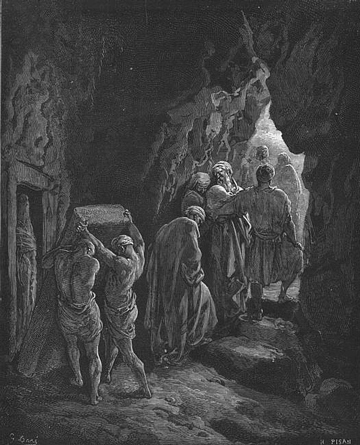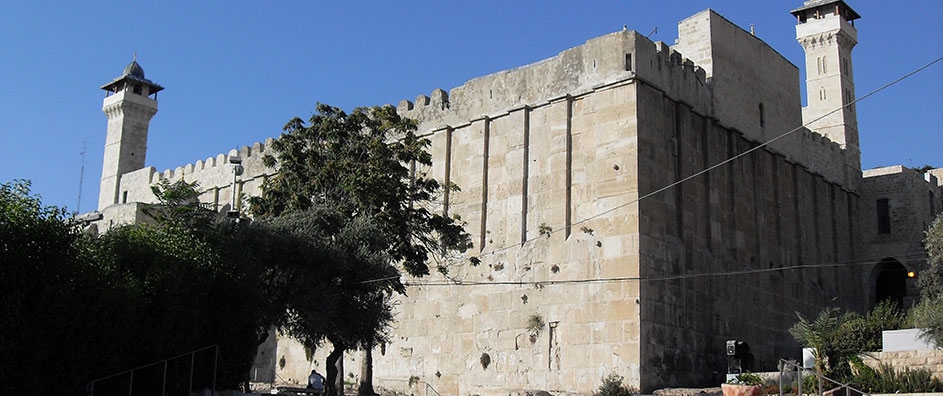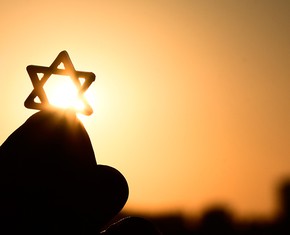The views expressed in our content reflect individual perspectives and do not represent the authoritative views of the Baha'i Faith.
When Abraham bought the cave of Machpelah as a burial place for his wife, Sarah, did anyone guess that it would eventually become one of the holiest spots on earth?

’Burial of Sarah’ by Gustave Dore
Machpelah means two caves or double caves, but that shouldn’t necessarily be taken as indicating huge underground caverns. A traditional burial cave in Canaan, whether natural or man-made, was often quite small, maybe the size of a small bathroom. It was connected to the surface of the earth by a vertical shaft or a horizontal passageway through which someone could carry a body or jar of bones. After entombment, the entrance to the cave would be sealed with a boulder or slab of rock. Stones, rubble, and earth would be thrown into the shaft, filling it and rising in a mound to mark the location. For a second interment, the mound would be removed and the shaft cleared out so that the tomb could be reentered.
When Abraham died, he was entombed in the cave of Machpelah with Sarah. Because Abraham had bought the land outright, as a permanent family burial place, Isaac inherited the rights to it and was also buried there, as was his wife, Rebekah. The body of Isaac’s son, Jacob, was mummified in Egypt, where he had been living, and it was carried back to Canaan so that he could also be placed in the tomb alongside the remains of his first wife, Leah. A few traditions say that Ishmael was buried in the tomb as well, but that seems unlikely.
As the number of people who believed in Abraham grew, so did the honor accorded the tomb. Hebron itself, located along one of the trade routes between Egypt and Mesopotamia, also grew, expanding from a small settlement into an important city. After the advent of Moses and the return of the Israelites, Jews flocked to the city as pilgrims, and many sought to be buried near the tomb, all of which added to the city’s renown. In 1000 BC, David was crowned king there and made it his capital. Later on, about a hundred years before the birth of Jesus, a nine-foot-thick wall of chiseled stone blocks was built around the site. The ruins of those walls still stand.
After the Romans invaded Palestine and sacked Jerusalem in 70 AD, many Jews fled to other countries, but a small group remained in Hebron with the specific intent of caring for Abraham’s tomb. When Christianity became the official religion of the Roman Empire, Jews were supplanted by Christians as official caretakers. Christians, who regarded Abraham as a forefather and revered him as a saint, were vigilant in their protection of the site. They built a roof over the walls, enclosing the area, and used it as a church, though Jews were still given at least occasional access to the tombs. When a formal basilica was built above the tombs in the Sixth Century, the custom of allowing Jewish access was continued, and Jews were also allowed to worship in a special section of the building.
Christian occupancy yielded to Muslim rule in 678 AD when a Muslim army took control of Hebron. Muslims, like Jews and Christians, venerated Abraham, and they continued the tradition of taking great care of the site. They converted the Christian basilica into the Mosque of Ibrahim, but it was reconverted to a church when Christian Crusaders successfully invaded in 1100. Eighty-seven years later, Muslims regained control, and they have maintained ownership of most of the site since then, although a Jewish area with a small synagogue still exists at the north side of the shrine area.
In spite of the fact that the followers of Judaism, Christianity, and Islam have not always gotten along well together, their shared respect for the tomb bought so carefully by Abraham has made it one of the oldest—perhaps the oldest—continually cared-for religious sites on Earth.
Its presence in the world today is a potent reminder of the enduring strength of the promises made to Abraham and his descendants:
… His enemies imagined that this exile would lead to His destruction and ruin. And indeed, if a man is banished from his native land, deprived of his rights, and oppressed from every side, he is bound—even if he be a king—to be reduced to naught. But Abraham stood fast and showed forth extraordinary constancy, and God changed His exile into abiding honour, till at last He established the oneness of God, for at that time the generality of mankind were idol worshippers.
This exile became the cause of the progress of Abraham’s descendants. This exile resulted in their being given the Holy Land. This exile resulted in the diffusion of Abraham’s teachings. This exile resulted in the appearance of a Jacob from the seed of Abraham, and of a Joseph who became ruler in Egypt. This exile resulted in the appearance of a Moses from that same seed. This exile resulted in the appearance of a being such as Christ from that lineage. This exile resulted in a Hagar being found, of whom Ishmael was begotten, and from whom in turn Muhammad descended. This exile resulted in the appearance of the Bab from the lineage of Abraham. This exile resulted in the appearance of the Prophets of Israel from the progeny of Abraham—and so it will continue forevermore. This exile resulted in the whole of Europe and most of Asia entering under the shadow of the God of Israel. Behold what a power it was that enabled an immigrant to establish such a family, to found such a nation, and to promulgate such teachings. – Abdu’l-Baha, Some Answered Questions, newly revised edition, pp. 14-15.
















Comments
Sign in or create an account
Continue with Googleor